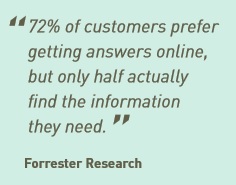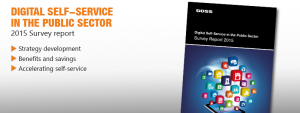Digital self-service is set to treble in three years!
A Goss Interactive survey undertaken in 2016 showed that the aim of the majority of public sector organisations was to move most of their services online.
Public sector bodies are aiming to increase the availability of digital self-service by 310% over the next three years, and expect to save £8.74 million each over the same period.
Delivering the ultimate Self-Service platform is a must for 100% customer engagement!
The hub of any Self-Service platform is your website – because your website should be at the heart of what you do and what you offer.
 It’s increasingly where your citizens and customers first go to for information, guidance and assistance. People will use your website in order to find the information they’re looking for, to request services, to buy services or products, to get help, and post their comments and feedback.
It’s increasingly where your citizens and customers first go to for information, guidance and assistance. People will use your website in order to find the information they’re looking for, to request services, to buy services or products, to get help, and post their comments and feedback.
Indeed one of your goals should be to direct more citizens and customers to your website rather than having them call your customer service desk!
It’s therefore essential that your website is well designed, easy on the eye, easy to navigate, and easy to use – as well as being topical, interactive, well managed and (hopefully) ‘bug free’!
If it’s none of the above, your customers will just call your customer service desk – which is a service that all authorities are trying to cut back on!
A survey of 355 senior managers from 256 organisations, conducted for web technology provider Goss Interactive, showed that while an average of 19% of services were now available digitally, this is expected to rise to between 50-100% over the period.
 Just over half of the organisations (56%) have a self-service strategy in place, often as part of broader strategies for customer contact or digital. Only 6% have it within channel shift and 5% as its own strategy area.
Just over half of the organisations (56%) have a self-service strategy in place, often as part of broader strategies for customer contact or digital. Only 6% have it within channel shift and 5% as its own strategy area.
Most already have the moves in the pipeline, with 40% saying there is a business case in place and 32% having plans to develop one over the next 12 months.
For local government, the areas where the move to self-service are expected to have the most importance are rubbish and recycling and council tax, both identified by more than 100 authorities. They are followed by planning and housing.
Prime Benefits
Reducing costs is seen as the prime benefit for the organisations, while providing access to services outside of office hours is the main benefit to customers.
 The results also suggest there will be a strong emphasis on the use of customer portals, with 206 of the responses identifying them as highly important. There is also a strong emphasis on mobile websites with strong content, identified by 193.
The results also suggest there will be a strong emphasis on the use of customer portals, with 206 of the responses identifying them as highly important. There is also a strong emphasis on mobile websites with strong content, identified by 193.
Rob McCarthy, chief executive officer of Goss Interactive, said: “In local government, there is a strategic move from shifting ad-hoc services to digital channels and to having a cross-organisation ‘self-service platform approach’.
“The next 12 months and beyond will be a critical time, with many organisations planning to significantly increase self-service to address budget deficits and improve service delivery. To this end, public sector organisations are working hard to deliver an integrated end-to-end approach to digital in general and self-service in particular.
“Even today, analysis of Goss clients’ web traffic shows that upwards of 40% of public sector transactions take place outside office hours and that figure is only set to increase. To meet these challenges, digital self-service is no longer optional – it is essential.”
(1) - Goss Interactive are a leading supplier of Content Management and mobile web solutions to over 70 local and central government departments.
Download – The Call Centre Decline? (PDF)

